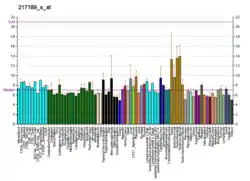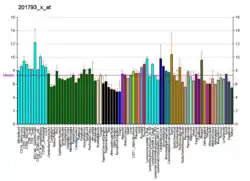SMG7
Protein SMG7 is a protein that in humans is encoded by the SMG7 gene.[5][6][7][8]
References
- GRCh38: Ensembl release 89: ENSG00000116698 - Ensembl, May 2017
- GRCm38: Ensembl release 89: ENSMUSG00000042772 - Ensembl, May 2017
- "Human PubMed Reference:". National Center for Biotechnology Information, U.S. National Library of Medicine.
- "Mouse PubMed Reference:". National Center for Biotechnology Information, U.S. National Library of Medicine.
- Ohnishi T, Yamashita A, Kashima I, Schell T, Anders KR, Grimson A, et al. (November 2003). "Phosphorylation of hUPF1 induces formation of mRNA surveillance complexes containing hSMG-5 and hSMG-7". Molecular Cell. 12 (5): 1187–200. doi:10.1016/S1097-2765(03)00443-X. PMID 14636577.
- Fukuhara N, Ebert J, Unterholzner L, Lindner D, Izaurralde E, Conti E (February 2005). "SMG7 is a 14-3-3-like adaptor in the nonsense-mediated mRNA decay pathway". Molecular Cell. 17 (4): 537–47. doi:10.1016/j.molcel.2005.01.010. PMID 15721257.
- "Entrez Gene: SMG7 Smg-7 homolog, nonsense mediated mRNA decay factor (C. elegans)".
- Yang L, Kraft VA, Pfeiffer S, Merl-Pham J, Bao X, An Y, et al. (June 2020). "Nonsense-mediated decay factor SMG7 sensitizes cells to TNFα-induced apoptosis via CYLD tumor suppressor and the noncoding oncogene Pvt1". Molecular Oncology. 14 (10): 2420–2435. doi:10.1002/1878-0261.12754. PMC 7530794. PMID 32602581.
Further reading
- Nakajima D, Okazaki N, Yamakawa H, Kikuno R, Ohara O, Nagase T (June 2002). "Construction of expression-ready cDNA clones for KIAA genes: manual curation of 330 KIAA cDNA clones". DNA Research. 9 (3): 99–106. doi:10.1093/dnares/9.3.99. PMID 12168954.
- Nagase T, Seki N, Ishikawa K, Ohira M, Kawarabayasi Y, Ohara O, et al. (October 1996). "Prediction of the coding sequences of unidentified human genes. VI. The coding sequences of 80 new genes (KIAA0201-KIAA0280) deduced by analysis of cDNA clones from cell line KG-1 and brain". DNA Research. 3 (5): 321–9, 341–54. doi:10.1093/dnares/3.5.321. PMID 9039502.
- Sood R, Bonner TI, Makalowska I, Stephan DA, Robbins CM, Connors TD, et al. (April 2001). "Cloning and characterization of 13 novel transcripts and the human RGS8 gene from the 1q25 region encompassing the hereditary prostate cancer (HPC1) locus". Genomics. 73 (2): 211–22. doi:10.1006/geno.2001.6500. PMID 11318611.
- Reichenbach P, Höss M, Azzalin CM, Nabholz M, Bucher P, Lingner J (April 2003). "A human homolog of yeast Est1 associates with telomerase and uncaps chromosome ends when overexpressed". Current Biology. 13 (7): 568–74. doi:10.1016/S0960-9822(03)00173-8. PMID 12676087. S2CID 14423276.
- Snow BE, Erdmann N, Cruickshank J, Goldman H, Gill RM, Robinson MO, Harrington L (April 2003). "Functional conservation of the telomerase protein Est1p in humans". Current Biology. 13 (8): 698–704. doi:10.1016/S0960-9822(03)00210-0. PMID 12699629. S2CID 6685276.
- Unterholzner L, Izaurralde E (November 2004). "SMG7 acts as a molecular link between mRNA surveillance and mRNA decay". Molecular Cell. 16 (4): 587–96. doi:10.1016/j.molcel.2004.10.013. PMID 15546618.
- Azzalin CM, Lingner J (February 2006). "The human RNA surveillance factor UPF1 is required for S phase progression and genome stability". Current Biology. 16 (4): 433–9. doi:10.1016/j.cub.2006.01.018. PMID 16488880. S2CID 17197870.
- Olsen JV, Blagoev B, Gnad F, Macek B, Kumar C, Mortensen P, Mann M (November 2006). "Global, in vivo, and site-specific phosphorylation dynamics in signaling networks". Cell. 127 (3): 635–48. doi:10.1016/j.cell.2006.09.026. PMID 17081983. S2CID 7827573.
This article is issued from Wikipedia. The text is licensed under Creative Commons - Attribution - Sharealike. Additional terms may apply for the media files.








